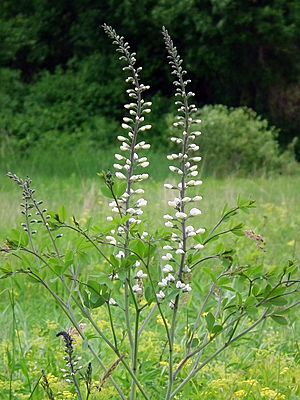White wild indigo facts for kids
Quick facts for kids White wild indigo |
|
|---|---|
 |
|
| Baptisia alba var. macrophylla | |
 |
|
| Baptisia alba var. alba | |
| Scientific classification | |
| Kingdom: | |
| (unranked): | |
| (unranked): | |
| (unranked): | |
| Order: | |
| Family: | |
| Genus: |
Baptisia
|
| Species: |
B. alba
|
| Binomial name | |
| Baptisia alba (L.) Vent.
|
|
| Synonyms | |
|
Baptisia lactea (Raf.) Thieret |
|
Baptisia alba, often called white wild indigo or white false indigo, is a type of herbaceous plant. This means it has soft stems, not woody ones like trees. It belongs to the Fabaceae family, which is also known as the bean or pea family. This plant grows naturally in central and eastern North America.
There are two main types, or varieties, of this plant. They are called Baptisia alba var. alba and Baptisia alba var. macrophylla.
Contents
White Wild Indigo: An Overview
White wild indigo is a beautiful plant that adds a lot to its natural home. It is known for its tall, upright stems. These stems are topped with lovely white flowers. The plant can grow quite tall, sometimes reaching over three feet high.
What Does it Look Like?
This plant has green leaves that are usually divided into three parts. The leaves are smooth and have a nice shape. In late spring or early summer, the plant produces many white flowers. These flowers grow in long clusters, making them very noticeable. After the flowers fade, they turn into interesting seed pods. These pods are often dark and rattle when dry.
Flowers and Seeds
The flowers of white wild indigo are shaped like typical pea flowers. They have five petals, with one large upper petal and two side petals. The two lower petals are often joined together. These flowers attract many different insects. After the flowers are pollinated, they develop into seed pods. These pods contain the plant's seeds.
Where Does it Grow?
White wild indigo is native to a large area of North America. You can find it growing in many states. It prefers open areas like prairies, woodlands, and savannas. It can also grow along roadsides and in clearings. This plant likes sunny spots and soil that drains well. It is quite tough and can grow in different types of soil.
Its Natural Home
- It is found in the Great Lakes region.
- It grows across the Great Plains.
- You can see it in the Northeastern United States.
- It is also common in the Southeastern United States.
Life Cycle of the Plant
White wild indigo is a perennial plant. This means it lives for many years. Each year, new stems grow from the roots. The plant flowers, produces seeds, and then the top part dies back in winter. The roots stay alive underground. They store energy for the plant to grow again next spring.
How it Reproduces
The plant mainly reproduces using its seeds. The seeds are inside the pods. When the pods dry out, they often split open. This releases the seeds. Sometimes, the whole plant can be moved by wind or water. This helps spread the seeds to new places. The plant can also spread slowly through its roots.
Why is it Important?
White wild indigo is important for its ecosystem. It provides food and shelter for various animals. Its flowers attract pollinators like bees and butterflies. These insects help the plant make seeds. The plant also helps improve the soil. Like other plants in the pea family, it can add important nutrients to the soil.
Benefits for Wildlife
- Pollinators: Bees, butterflies, and other insects visit its flowers. They collect nectar and pollen.
- Host Plant: Some butterfly larvae, or caterpillars, eat the leaves of Baptisia plants. This helps them grow.
- Soil Health: The roots of this plant have special bacteria. These bacteria take nitrogen from the air. They turn it into a form that plants can use. This makes the soil healthier for other plants too.
Growing White Wild Indigo
Many people like to grow white wild indigo in their gardens. It is a good choice for native plant gardens. It is easy to care for once it is established. It does not need much water once it has grown strong roots. It also helps support local wildlife.

